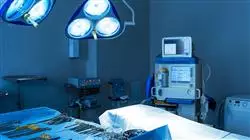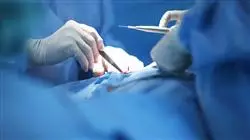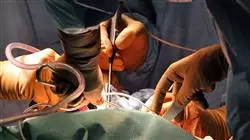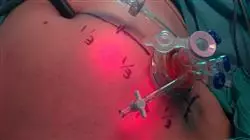University certificate
The world's largest faculty of medicine”
Description
This Professional master’s degree is aimed at specialists who want to update their knowledge and learn the latest techniques in Minimally Invasive Surgery in Pediatrics”

Comprehensive training in minimally invasive techniques (laparoscopy and endoscopy) is not acquired in the undergraduate or postgraduate teaching programs of the different surgical specialties.
In addition to needing to provide in-depth knowledge of these techniques, this type of program must also include a specific theoretical and practical teaching methodolody. The fact that these techniques are offered in hospitals is a seal of quality in health care. Nowadays, patients’ parents who are familiar with the latest technologies demand specialized professionals who can treat their children with minimally invasive techniques such as endoscopy and laparoscopy. These techniques can help physicians to diagnose and treat many of the surgical pathologies of pediatric patients.
Therefore, it is logical to promote the training of professionals in this discipline, as their education is not regulated and so they have to rely on postgraduate training that is taught by different professionals who are experts in this field.
In this Professional master’s degree, the majority of endoscopic and laparoscopic techniques used today on pediatric patients will be studied in depth. The program will cover airway, digestive and urinary tract endoscopy, as well as laparoscopic techniques used in general and thoracic surgery and gynecology and urology. Focusing primarily on minimally invasive techniques, we will review the part of pediatric surgery that can be diagnosed or treated through using these techniques.
In order to ensure this, the best experts in the field will contribute their personal experience and present the latest trends in each of their areas of expertise.
Improve the quality of your patient care with this highly scientifically rigorous education”
This Professional master’s degree in Minimally Invasive Surgery in Pediatrics contains the most complete and up-to-date scientific program on the market. The most important features include:
- The latest technology in online teaching software
- A highly visual teaching system, supported by graphic and schematic contents that are easy to assimilate and understand
- Practical cases presented by practicing experts
- State-of-the-art interactive video systems
- Teaching supported by telepractice
- Continuous updating and recycling systems
- Autonomous learning: full compatibility with other occupations
- Practical exercises for self-evaluation and learning verification
- Support groups and educational synergies: questions to the expert, debate and knowledge forums
- Communication with the teacher and individual reflection work
- Content that is available from fixed or portable any device with an Internet connection
- Supplementary documentation databases are permanently available, even after the course
Apply the latest trends in Minimally Invasive Surgery in Pediatrics into your daily professional practice”
Our teaching staff is composed of medical professionals, who are currently practicing specialists. That way, we can ensure that we offer students the up-to-date training that we at TECH aim to provide. We have a multidisciplinary team of qualified and experienced physicians from different fields who will demonstrate the theoretical knowledge in an efficient manner, but, above all, will contribute to the course the practical knowledge derived from their own experience: one of the differential qualities of this Professional master’s degree.
Mastery of the subject will be complemented by the effective methodology used throughout this Professional master’s degree by our multidisciplinary team of e-learning experts. It integrates the latest advances in educational technology and so you will be able to study with a range of comfortable and versatile multimedia tools that will give you the operability you need in your learning.
The design of this program is based on Problem-Based Learning: an approach that conceives learning as a highly practical process. To achieve this remotely, we will use telepractice learning: with the help of an innovative interactive video system and learning from an expert, you will be able to acquire the knowledge as if you were actually dealing with the scenario you are learning about. A concept that will allow you to consolidate what you have learned in a more realistic and permanent way.
You will have access to the latest multimedia tools, designed by experts in Minimally Invasive Surgery in Pediatrics, which will favor the speed of assimilation and learning"

This program uses the latest advances in educational technology, based on the e-learning methodology"
Syllabus
The structure of the contents has been designed by a team of experts, and includes all the latest information on Minimally Invasive Surgery in Pediatrics.

This Professional master’s degree is a quality program adapted to the latest trends in the field of minimally invasive surgery”
Module 1. Genitourinary Endoscopy
1.1. Equipment. Cystoscopes and Ureterorenoscopes
1.2. Instrumentation Material
1.3. Hydronephrosis. Ureterohydronephrosis
1.3.1. Pyeloureteral Stenosis Anterograde and Retrograde Dilatation and Endopyelotomy
1.3.2. Congenital Obstructive Megaureter Dilatation of the Ureterovesical Junction
1.4. Bladder Pathology I
1.4.1. Ureteral Vesic Reflux: Injection of Material at the Ureterovesical Junction
1.5. Bladder Pathology II
1.5.1. Cystoscopy Bladder Masses
1.5.2. Bladder Diverticulum Ureterocele
1.6. Bladder Pathology III
1.6.1. Bladder Dysfunction Botox Injection
1.7. Urethral Pathology
1.7.1. Ureteral Stenosis, Ureteral Traumatism, Urethrotomy
1.7.2. Urethra Valves Urethral Diverticula
1.8. Lithiasis I
1.8.1. Percutaneous Nephrolithotomy
1.8.2. Retrograde Intrarenal Surgery
1.9. Lithiasis II
1.9.1. Ureteral Lithiasis. Ureterorenoscopy
1.9.2. Bladder Lithiasis Enterocystoplasties and Catheterizable Ducts
1.10. Gynecological Pathology
1.10.1. Urogenital Sinus Sewer
1.10.2. Vaginal Malformations
Module 2. Endoscopy Via Digestive Tract
2.1. Team, Instrumentation and Pre-Procedure Patient Preparation
2.2. Sedation and Anesthesia for Digestive Endoscopic Procedures With Children
2.3. Esophagus I
2.3.1. Esophageal Stricture, Achalasia, Esophageal Dilatation and Endoluminal Prostheses
2.3.2. Extraction of Foreign Bodies from the Esophagus
2.4. Esophagus II
2.4.1. Esophageal Varices Ligation of Varicose Veins
2.5. Caustic Injuries
2.6. Stomach I
2.6.1. Percutaneous Gastrostomy
2.6.2. Anti-Reflux Surgical Techniques
2.7. Stomach II
2.7.1. Gastric Lesions Excision
2.7.2. Gastric Foreign Bodies Bezoars
2.8. Pyloro-Duodenal Pathology
2.8.1. Pyloric Stenosis
2.8.2. Duodenal Stenosis and Duodenal Cysts
2.9. Colon I
2.9.1. Colonoscopy Rectal Stenosis
2.9.2. Ulcerative Colitis
2.9.3. Colorectal Polyps
2.10. Colon II
2.10.1. Chromoendoscopy
2.10.2. Capsuloendoscopy
Module 3. Airway Endoscopy
3.1. Sedation and Anesthesia in Pediatric Bronchoscopy
3.2. Bronchoscopy
3.2.1. Exploration of the Airway in the Otorhinolaryngological Practice
3.2.2. Equipment and Instrumentation in Rigid and Flexible Bronchoscopy
3.2.3. Indications of Rigid and Flexible Bronchoscopy
3.3. Diagnostic Procedures I
3.3.1. Bronchoalveolar Lavage
3.3.2. Total Lung Lavage
3.4. Diagnostic Procedures II
3.4.1. Endobronchial and Transbronchial Biopsy
3.4.2. EBUS (Ultrasound-Guided Biopsy)
3.4.3. Bronchoscopy and Study of Swallowing
3.5. Therapeutic Procedures I
3.5.1. Extraction of Foreign Bodies
3.5.2. Pneumatic Dilation
3.5.3. Placement of Stents in the Airway
3.6. Therapeutic Procedures II
3.6.1. Laser Procedures
3.6.2. Cryotherapy
3.6.3. Other Techniques: Endobronchial Valves, Sealants and Drug Application
3.6.4. Technique Complications
3.7. Specific Laryngeal Pathologies I
3.7.1. Laryngomalacia
3.7.2. Laryngeal Paralysis
3.7.3. Laryngeal Stenosis
3.8. Specific Laryngeal Pathologies II
3.8.1. Laryngeal Tumors and Cysts
3.8.2. Other Less Frequent Pathologies: Clefting
3.9. Specific Tracheobronchial Pathologies I
3.9.1. Tracheal/Bronchial Stenosis: Congenital and Acquired
3.9.2. Tracheobronchomalacia: Primary and Secondary
3.10. Specific Tracheobronchial Pathologies II
3.10.1. Tumors
3.10.2. The Tracheotomized Patient: Care
3.10.3. Other Less Frequent Pathologies: Clefting, Granuloma
Module 4. Thoracoscopy. Cervicoscopy
4.1. Anesthesia for Pediatric Thoracoscopy
4.2. Equipment, Material and Bases of Thoracoscopy
4.3. Chest I
4.3.1. Pectus Excavatum Nuss Bar Placement
4.4. Chest II
4.4.1. Pneumothorax
4.4.2. Debridement and Placement of Endothoracic Drainage Empyema
4.5. Chest III
4.5.1. Lobectomy in Children. Pulmonary Airway Malformation (CPAM)
4.5.2. Pulmonary Sequestration. Congenital Lobar Hyperinsufflation
4.6. Chest IV
4.6.1. Mediastinal Tumors
4.6.2. Esophageal Duplications Bronchogenic Cysts
4.7. Chest V
4.7.1. Pulmonary Biopsy
4.7.2. Removal of Metastases
4.8. Chest VI
4.8.1. Patent Ductus Arteriosus/Vascular Rings
4.8.2. Aortopexy Tracheomalacia
4.9. Chest VII
4.9.1. Palmar Hyperhidrosis
4.9.2. Treatment Thoracoscopic of Chylothorax
4.10. Cervicoscopy
4.10.1. Minimally Invasive Thyroid, Parathyroid and Thymus Surgery
Module 5. Laparoscopy General and Digestive (I)
5.1. Anesthesia for Abdominal Laparoscopic Surgery
5.2. Materials and General Aspects of Laparoscopy
5.3. Gastrointestinal Tract I
5.3.1. Esophageal Achalasia
5.3.2. Gastroesophageal Reflux. Fundoplication
5.4. Gastrointestinal Tract II
5.4.1. Laparoscopic Gastrectomy
5.4.2. Pyloromyotomy
5.5. Gastrointestinal Tract III
5.5.1. Bowel Intussusception
5.5.2. Treatment of Intestinal Obstruction
5.6. Gastrointestinal Tract IV
5.6.1. Meckel's Diverticulum
5.6.2. Intestinal Duplications
5.7. Gastrointestinal Tract V
5.7.1. Acute Appendicitis
5.8. Gastrointestinal Tract VI
5.8.1. Laparoscopy in Inflammatory Bowel Disease
5.9. Gastrointestinal Tract VII
5.9.1. Hirschsprung's Disease
5.9.2. Anorectal Malformations
5.10. Gastrointestinal Tract VIII
5.10.1. Laparoscopy for Stomas
5.10.2. Rectopexy
Module 6. Laparoscopy Surgery General and Digestive (II)
6.1. Liver I. Biliary Tract
6.1.1. Cholecystectomy
6.2. Liver II Biliary Tract
6.2.1. Biliary Tract Atresia Portoenterostomy of Kasai
6.2.2. Choledochal Cyst
6.3. Liver III
6.3.1. Hepatectomy
6.3.2. Hepatic Cysts
6.4. Spleen/Pancreas
6.4.1. Splenectomy Techniques
6.4.2. Laparoscopic Approach to the Pancreas
6.5. Abdomen I
6.5.1. Ventriculoperitoneal Shunts
6.5.2. Catheters of Peritoneal Dialysis
6.6. Abdomen II
6.6.1. Abdominal Trauma
6.7. Abdomen III
6.7.1. Chronic Abdominal Pain
6.8. Obesity Surgery
6.8.1. Laparoscopic Techniques for Obesity
6.9. Diaphragm
6.9.1. Morgagni’s Hernia
6.6.2. Diaphragmatic Relaxation
6.10. Abdominal Wall
6.10.1. Inguinal Hernia. Laparoscopic Inguinal Herniorrhaphy
Module 7. Oncologic Laparoscopy: Gonadal Laparoscopy
7.1. Laparoscopy in Pediatric Tumors (I)
7.1.1. Laparoscopy for Intra-abdominal Tumor Lesions
7.2. Laparoscopy in Pediatric Tumors (II)
7.2.1. Adrenalectomy: Neuroblastoma
7.3. Laparoscopy in Pediatric Tumors (III)
7.3.1. Sacrococcygeal Teratomas
7.4. Laparoscopy in Pediatric Tumors (IV)
7.4.1. Ovarian Tumors
7.5. Testicular Laparoscopy (I)
7.5.1. Non-Palpable Testicle: Diagnosis and Treatment
7.6. Urachal Abnormalities
7.7. Gynecology Laparoscopy (I)
7.7.1. Peripubertal Ovarian Cysts
7.8. Gynecology Laparoscopy (II)
7.8.1. Ovarian Torsion
7.8.2. Tubal Pathology
7.9. Gynecology Laparoscopy (III)
7.9.1. Uterovaginal Malformations
7.10. Gynecology Laparoscopy (IV)
7.10.1. Laparoscopy in Sexual Differentiation Disorders
Module 8. Urological Laparoscopy
8.1. Upper Urinary Tract I
8.1.1. Renal Annulment Transperitoneal Nephrectomy
8.1.2. Renoureteral Duplication Transperitoneal Heminephrectomy
8.2. Upper Urinary Tract II
8.2.1. Retroperitoneal Nephrectomy
8.2.2. Retroperitoneal Heminephrectomy
8.3. Upper Urinary Tract III
8.3.1. Pyeloureteral Stenosis (Transperitoneal and Retroperitoneal)
8.4. Upper Urinary Tract IV
8.4.1. Retrocaval Ureter
8.5. Upper Urinary Tract V. Renal Tumor Surgery
8.5.1. Wilms Tumor
8.5.2. Partial Oncologic Nephrectomy
8.6. Lower Urinary Tract I
8.6.1. Extravesical Ureteral Reimplantation
8.6.2. Bladder Diverticulum
8.7. Lower Urinary Tract II
8.7.1. Enterocystoplasty
8.7.2. Bladder Neck Reconstruction
8.8. Lower Urinary Tract III
8.8.1. Appendicovesicostomy
8.9. Lower Urinary Tract IV
8.9.1. Prostatic and Seminal Pathology
8.10. Pneumovesicoscopy
8.10.1. Ureteral Reimplantation
8.10.2. Bladder Diverticulum
8.10.3. Bladder Neck Surgery
Module 9. Neonatal and Fetal Surgery
9.1. Fetal Endoscopy
9.1.1. General and Technical
9.2. Successful Techniques
9.3. Fetal Posterior Urethral Valve Surgery
9.4. Fetal Treatment for Congenital Diaphragmatic Hernia
9.5. Neonatal Congenital Diaphragmatic Hernia
9.6. Long-Gap Esophageal Atresia/ Esophageal Atresia
9.7. Duodenal Atresia
9.8. Intestinal Atresia
9.9. Intestinal Malrotation
9.10. Neonatal Ovarian Cysts
Module 10. Abdominal Surgery Through Single Port and Robotic Surgery
10.1. Materials and Generalities of Laparoscopic Single Port Surgery
10.2. Single-Port Appendectomy
10.3. Single-Port Nephrectomy and Heminephrectomy
10.4. Single Port Cholecystectomy
10.5. Inguinal Herniorrhaphy
10.6. Materials and General Aspects of Robotic Surgery
10.7. Thoracic Robotic Surgery
10.8. Abdominal Robotic Surgery
10.9. Urological Robotic Surgery

A unique, key, and decisive experience to boost your professional development”
Professional Master's Degree in Minimally Invasive Surgery in Pediatrics
If there is something that should characterize the expertise of a physician, it is the methodical approach, both to diagnose and to finally cure the patient. Performing surgery on a person is the ultimate demonstration of this attribute and if this applies to an adult individual, it is even more so for a child patient, especially with regard to minimally invasive techniques, which are the most requested by parents and general practitioners. The Professional Master's Degree in Minimally Invasive Surgery in Pediatrics developed by TECH responds not only to this approach, but to an even greater need, the absence of academic programs that specialize medical personnel in these practices. The knowledge to perform an endoscopy or laparoscopy, are acquired exclusively internally in clinics, doctors with more experience in such techniques instruct their assistants in them, so a very small number of people can perform in these exclusive areas. Here in our online university we give you the opportunity to train in these fundamental surgical methods, through flexible schedules, with access to a vast amount of informative multimedia content.
Specialize in minimally invasive surgeries
Of all the sectors of the population, one that demands priority attention is children's surgery. Increasingly, healthcare professionals are seeking to rely on new technologies to treat children in ways that will lead to greater results while minimizing pain or unwanted sequelae to a minimum. This is the origin of the minimally invasive surgeries that our Professional Master's Degree explores in depth. Laparoscopy, for example, causes less postoperative pain and makes recovery faster, also has smaller incision size compared to traditional open surgery, leaving a better aesthetic appearance to the scar. The program provided by TECH will allow you not only to learn how to handle general and digestive laparoscopy, but also its other modalities such as oncologic and urologic. We will also teach you other procedures such as robotic or abdominal surgery through a single port, and neonatal or fetal surgery, so indispensable in pediatrics. Do not stay in the basics, give a new category to your career and help the little ones. At TECH we turn you into a renowned professional.







